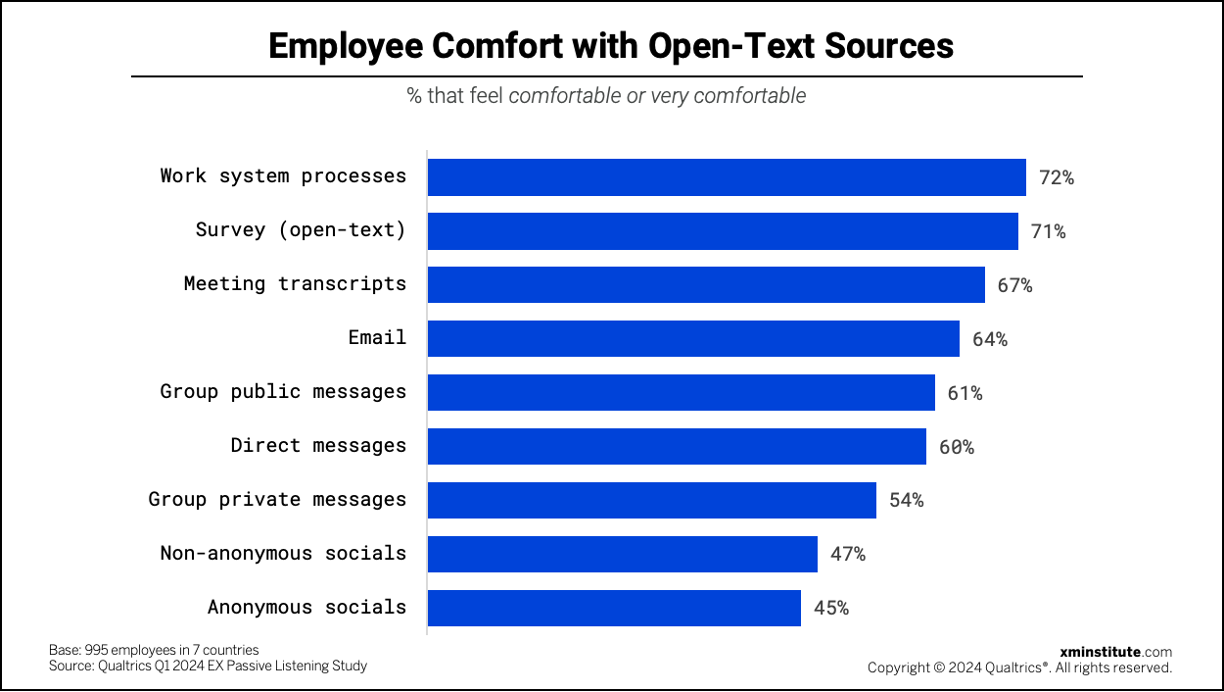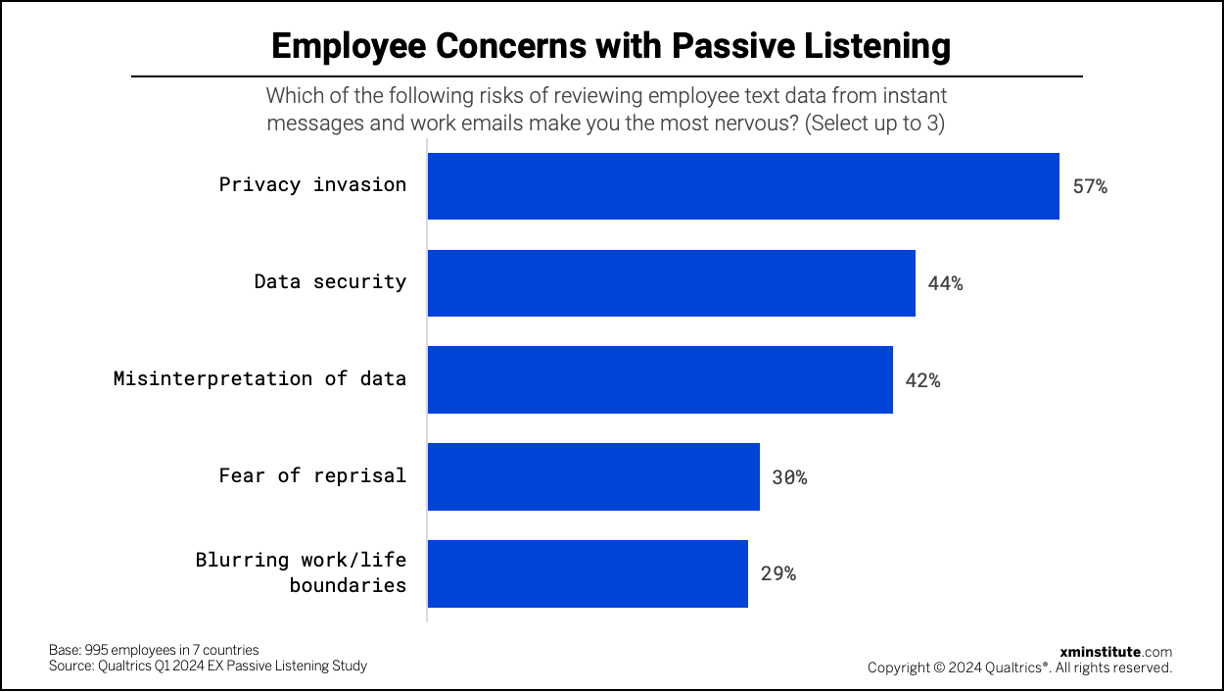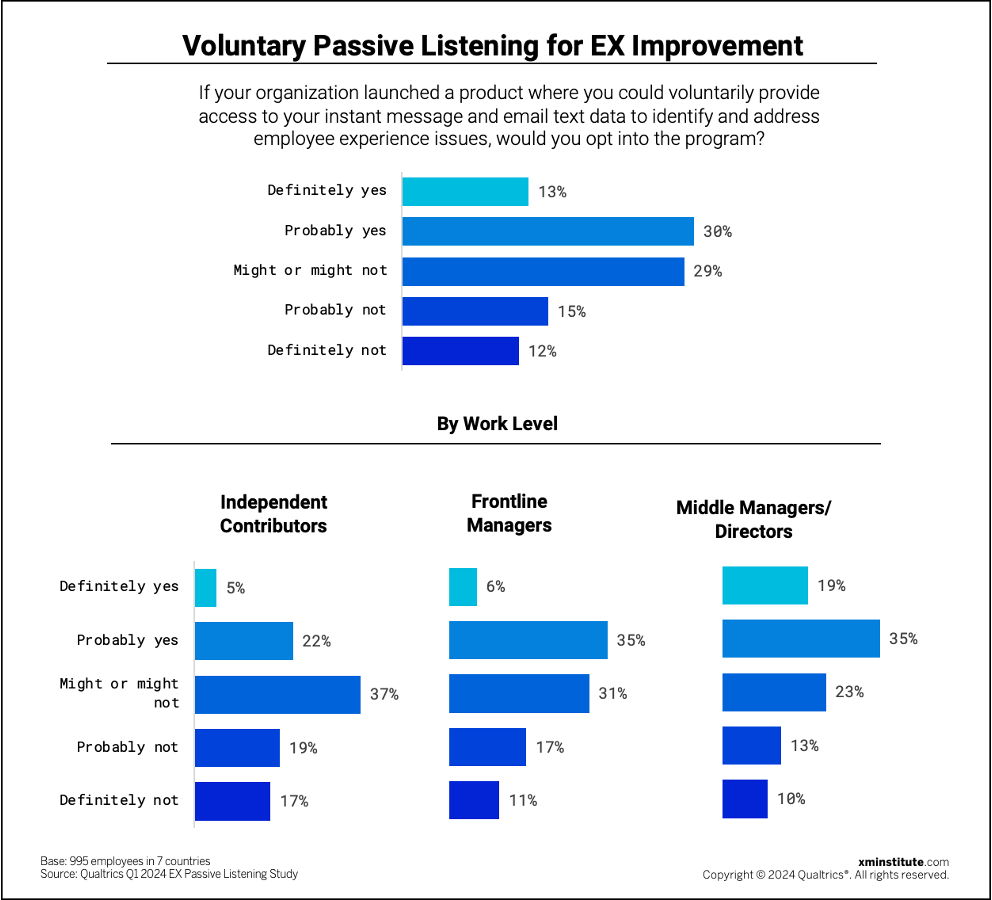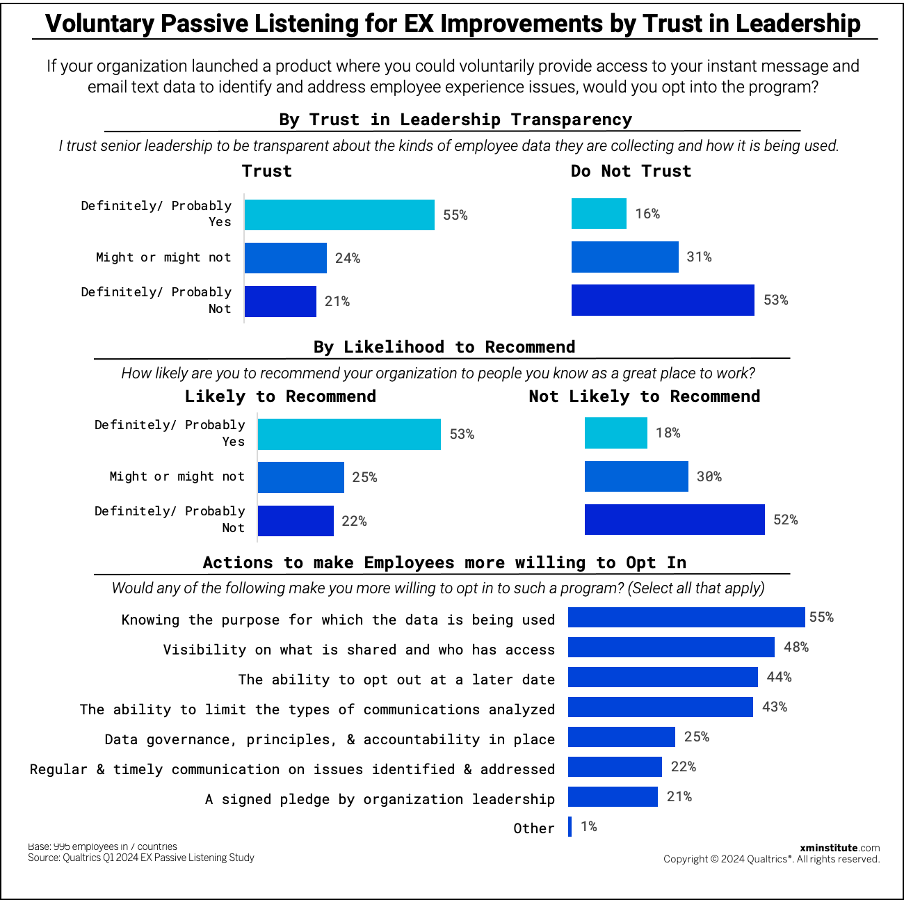According to Qualtrics research, 77% of employees say they want to give more frequent feedback. However, while employees want to be heard, they don’t want to complete a survey every day. Similarly, managers and HR teams don’t want to build weekly action plans or set up monthly programs based on employee feedback. Everyone is looking for a way to effectively use employee insights to drive continuous improvement, without it becoming overwhelming. These emerging demands are fueling innovation in employee experience (EX) management, including new practices in passive listening.
Passive Employee Listening is on the Rise
Passive employee listening practices tap into unsolicited data, which employees generate as part of their day-to-day activities without being asked to – like declining a meeting, answering a question in a public channel, or emailing a customer. Capturing this type of passive data can help organizations produce more predictive, actionable insights and enrich their overall understanding of the employee experience.
Given that most of this data is unstructured text, the rise in passive listening methods is being driven by increased access to artificial intelligence (AI) tools that use machine learning models to access, analyze, and explain it. HR teams today are able to tap into these emerging AI capabilities to collect and process this type of unsolicited, unstructured data, making it increasingly efficient to use these insights to inform actions that improve employee experiences and organizational outcomes.

Compared to more traditional, solicited, survey-based listening, passive listening sources open up a number of new opportunities, such as:
- Continuous and timely insights. With passive listening, employees can share more information about their work experiences in the moments when they feel the strongest about what happens, as it happens. Rather than structured and solicited feedback, where they wait for a survey to be sent to them days, weeks, or even months later, employees’ passive data fills the gaps, providing an ongoing flow of information about people’s experiences.
- Harness existing data. With passive listening you may already have the data you need to better understand and improve employee experiences, without having to create more surveys (and have employees spend more time filling them in). Employees drop hints and clues about their everyday experiences through their daily communication and actions, which can collectively provide a broader picture of people’s experiences at work.
- Employee-centered insights. With passive listening, you are not constrained by specific questions or last quarter’s feedback topics. You can learn what employees are currently experiencing and use the information to inform more structured feedback channels such as surveys. This means when global events impact specific parts of your business, or there is a sudden change for a particular department, you can see in real time the impact of these activities.
However, passive listening also comes with some challenges that are important for leaders to consider and address as they design a passive listening program:
- Privacy concerns. Privacy is all about the ability to control the information others have about you. The use of individual data for a purpose other than what it was shared for puts privacy at risk. For a passive listening program to work, it must be secure, transparent in its function, and understood by those whose data it uses.
- Lack of precedent. Passive listening relies on AI, which itself is a rapidly evolving practice that continues to break new ground. Naturally, it is reasonable to exercise caution when adopting this new technology, and many HR professionals are rightfully cautious about implementing passive listening programs. With the speed at which employee experience technology capabilities are developing, there is a lack of precedent for HR professionals to lean on when implementing these new practices. Even with the best intentions to improve employee experience, HR teams must always balance their responsibility as custodians of employee privacy and remain keenly aware of risks associated with overstepping employee comfort levels.
- Lots of noise. When you get signals about everything, it can be difficult to narrow down the most important or salient pieces of information if you don’t know what to look for. For passive listening infrastructure to effectively collect and process this data, it must be supported by a clear EX strategy and systems that enable the organization to take action. Otherwise, managers and leaders will struggle to translate this data into timely decisions.
Insights into Employee Comfort with Passive Listening
As passive listening becomes an integrated part of Employee Experience Management (EXM), HR teams have met these practices with both excitement and caution. To help organizations understand how employees actually feel about their employers using open-text data from unsolicited channels, as part of a global research study, we asked nearly 1,000 desk workers about their perceptions around passive listening practices1.
Some of the most notable findings from this study include:
- Most employees are comfortable with passive listening. A majority of employees say they are open to employers capturing unsolicited data, though comfort levels differ across data networks and platforms.
- Privacy is the top concern. All employee groups identified privacy invasion as a top concern for passive listening.
- Comfort varies across work levels. Leaders are more comfortable with passive listening practices compared to individual contributors.
- Trust correlates with comfort. When employees say they trust their organization and its leaders, they are more willing to volunteer their unsolicited data as a form of feedback.
Finding #1: Most Employees are Comfortable with Passive Listening
While unstructured data can come in a variety of forms – including videos, audio, and images – for this study, we focused specifically on unstructured data in the form of open-text, which can come from any natural language communication source and live in a variety of communication channels. For this research, we included nine channels specifically – seven internal workplace channels, such as email and work systems, and two general external channels: anonymous and non-anonymous social media platforms. While eight of these nine channels are unsolicited, we also included one solicited listening channel – open-text survey responses – for comparison.

Key findings here include:
- The majority of employees are comfortable with passive listening. Depending on the source, up to 72% of employees are open to passive listening practices in their workplace. These insights expand on and are consistent with our previous research findings that employees are more open to passive listening than might be expected, with a global average score of 56% for openness to passive listening.
- Employees are most comfortable sharing data from internal work systems. Employees are quite comfortable with the organization using open-text data collected from internal workplace sources (software used at work, for work) to generate insights about their experiences. Employees feel most comfortable with organizations harnessing data from work processes (72%) and meeting transcripts (67%). Interestingly, these numbers are comparable to the solicited data source – open-text survey responses (71%) – which is a more traditional and familiar listening method, and acts as a benchmark of employee comfort for sharing text-based feedback.
- Employees are least comfortable with social media listening. Employees prefer organizations to source passive data from internal work channels rather than external social media channels, regardless of whether those socials are anonymous or non-anonymous. In fact, they were least comfortable with anonymous social media channels, such as Reddit and Glassdoor, closely followed by non-anonymous channels like LinkedIn. This is most likely due to employees’ perceptions of intent, consent, and reciprocity from their employers looking at external channels. To feel comfortable with these listening practices, the intent or purpose for collecting passive data must be mutually beneficial for both the employee and the organization. Employees are more likely to consent to the organization accessing their information through work systems as – not only is it clearer how their feedback and personal data could improve their experiences at work – but they already tend to conduct themselves knowing that this information is visible and retrievable to some degree. There is no such agreement in private spaces that the employer does not administer. When it comes to social media, it is likely the risk is higher than the reward for the employee.
Finding #2: Privacy is the Top Concern
These listening practices are evolving quickly, and as with any new technology, people are reasonably cautious. As part of this research study, we asked employees to identify their top concerns with their organization establishing passive listening programs.

Key findings here include:
- A majority are worried about privacy. Privacy invasion is the most common concern, with 57% of all employees citing this as their top issue. This reinforces the previous finding that employees feel least comfortable – by a substantial margin – with organizations collecting information from social media channels. Understandably, employees seem to feel that not all available text sources are representative of who they are professionally and would not want organizations breaching the wall between their private and professional selves just to capture richer feedback.
- Ethical guardrails are needed to address data security and privacy concerns. More than half of employees hold concerns about privacy and security, and either personal privacy or data security overall was the top concern in every region we ran this study. This is why establishing and being accountable to ethical principles is essential for all modern employee listening programs. To ensure these principles are cascaded and strengthened, consider establishing a cross-functional ethics committee that has the oversight and influence needed to prioritize employee outcomes.
- Employees worry more about misinterpretation of data than fear of reprisal. Employees are more concerned with the organization misinterpreting their data than they are about reprisal from their data being used. This may be a surprise to HR leaders, who would assume that employees are most concerned about retaliation in response to things they say. However, they are more concerned about their data being misunderstood, or taken out of context.
Finding #3: Comfort with Passive Listening Varies Across Levels
Much like we found in our 2024 EX Trends research, comfort with passive listening is related to employee work level. As part of this research study, we asked respondents whether they would proactively opt into a passive listening program if the organization used the data to identify and close experience gaps. In addition to work levels, we also asked about other demographic categories – including country, age, gender, tenure, and days spent in office – but we found that only work level was a predictor of likelihood to opt into passive listening programs.

Key findings here include:
- Most employees are at least open to the idea of participating in a passive listening program. Only 12% of employees say they would definitely not opt into this type of listening program. For individual contributors (who are also the most unsure), this number is 17% – the highest of any group.
- Middle Management and above are likely to opt in. The higher an employee’s level within an organization, the more comfortable they are with these programs and the more likely they are to opt in to sharing their passive data. At the individual contributor level, just 5% said they would definitely opt into a passive listening program, and this jumps to 19% for more senior leaders. For those in middle management and above, these programs are met with positivity, with more than half (54%) saying they would volunteer their data.
- Most employees are on the fence. Across all levels, a large proportion of employees are waiting to be convinced. While most (30%) lean towards probably yes, 29% of respondents said they were unsure and 15% are leaning towards probably no. It is the lower levels of the organization who are most unsure, with over a third of the group (37%) saying they might or might not opt into a passive listening program. Connecting with these employees by demonstrating the value of AI-enhanced processes, which protect privacy and maintain autonomy, are essential to build their trust. This requires capturing quick wins and communicating how they are benefiting both employees and the organization.
Finding #4: Trust in Leaders and Comfort Passive Listening are Connected
The level of employee engagement and trust in senior leaders are key factors in employee willingness to opt into a passive listening program. Trust – the willingness of a person to be vulnerable to the actions of another, based on the expectation that they will act in a way important to the trustor, irrespective of their ability to monitor or control them – is foundational to successful Experience Management. Trust is built on mutual action, and is a prerequisite for employees voluntarily sharing information about themselves, as long as they believe it will be used to improve their experiences in return.

The findings show that:
- Trust in senior leaders to be transparent about the use of data is essential. When asked how willing they would be volunteer their email or instant message data in an effort to improve employee experience, more than half (55%) of respondents who trust their senior leaders to be transparent about the use of this data said they would open to it, whereas more than half of those with low trust (53%) would not. This connection is strong – compared to those who are open to opting in, respondents who say they would not opt into a passive listening program were 2.5x more negative about trust in their senior leader’s transparency.
- Opt-in rates are connected to employee engagement. Employee’s likelihood to recommend your organization to people they know is a core element of employee engagement, and shows a similar relationship with opting into passive listening. Over half of employees (53%) in the study who say they would recommend their organization would be open to the idea, whereas more than half (52%) of low likelihood to recommend said they would not. This strongly reinforces how organizational culture is a critical factor in predicting employee comfort with passive listening methods in your organization. While enhanced employee listening may seem like a pathway to increased engagement, without strong foundations, these programs will need to be implemented more strategically. This will require a high level of focus on communications, collaboration with employees and expanding the listening portfolio incrementally over time to build trust.
- Transparency and agency are key to employee comfort. We asked employees who weren’t sure or responded negatively about opting in if anything could change their minds. Two conditions consistently surfaced. First, be transparent. A majority said that knowing the purpose of data collection, what is shared and who has access would increase their chances of opting in. The second condition was having agency – with 44% of respondents saying the ability to decide to opt out later would make them more willing to opt in.
Recommendations for Implementing Passive Listening Programs
Overall, it’s clear that passive listening programs have viability, and most employees would consider opting into these programs if they knew how the organization planned to use the data and if it were used to improve their experiences at work. Based on these findings, we encourage the following actions for organizations considering passive listening methods:
- Build in transparency. Employees want to know what is happening with their data, before they volunteer it. Be explicit about how unstructured or unsolicited data will be collected, analyzed, stored, shared, and accessed in your organization. Having policies or ethical guidelines around data collection and use will help structure communications, foster transparency and maintain it over time. As a starting point, check out the Qualtrics Ethical XM Guidelines, which were written specifically for AI use cases such as passive listening in XM.
- Offer the choice of opting out. By giving employees the option to participate or not, you provide employees with agency over their information and improve employee trust. Informing employees of data collection and intended outcomes gives them the option to limit their participation or remove their data altogether, and will help address uncertainty and privacy concerns employees may have.
- Ensure privacy. On top of implementing safe and secure technology platforms that enable ethical use of data, organizations should define their own privacy policies and communicate these policies to employees, which will help build employee trust in the security of their data. This includes considering the security and storage of data collected (e.g., making sure it is encrypted and only visible to authorized personnel), having purpose and use limitations for data (e.g., not using it for individual evaluations or disciplinary action), and having set boundaries on data retention (e.g., knowing the expiry date on data storage securely delete it).
- Tailor communications. Develop targeted communication strategies that address specific concerns and expected benefits relevant to different employee groups, particularly those at different work levels. Highlight the benefits that come with a passive listening program, and proactively address concerns that guarantee privacy & data security. For individual contributors, focus more on tangible daily improvements like workplace safety and technology improvements, while for frontline or mid-level managers, you might highlight the value of employee generated innovations or knowing their opinions on work processes. Ensure employees understand the boundaries of these programs, their ability to opt in or out, and encourage all stakeholders to share feedback about the insights and their experience using passive listening.
- Test your own assumptions. HR leaders are understandably risk averse as they often manage employee experiences and expectations for large and complex organizations. The downside is that risk aversion can also mean avoiding the unknown, taking less creative routes to get to their end goal, or waiting for other organizations to write the playbook before acting. This research is the start of that playbook. Employees have concerns, but they are not as uncomfortable with passive listening and the use of AI as many HR leaders would think. Given how quickly this space is evolving, continue to test assumptions and explore new options for understanding and improving employee experiences.
- Foster organizational trust. Enhance efforts to improve organizational trust as it directly impacts the willingness of employees to participate in monitoring programs. By acting on the other recommendations, and demonstrating the value of AI-enhanced processes that protect privacy and improve employee experiences, will build trust over time.
The bottom line: Employees are thinking about passive listening as AI becomes commonplace and their perceptions are impacted by their overall workplace experience.
Grace Van Dam is an Employee Experience Product Scientist for Qualtrics
Matthew Evans, MBA, is a Senior Employee Experience Product Scientist for Qualtrics
Dr. Cecelia Herbert, XMP, PsyD, is a Principal Catalyst for Qualtrics XM Institute
- To learn how employees feel about passive listening practices in their workplace, the Qualtrics XM Scientists teams ran a global study, including participants from Australia, France, Germany, Japan, Singapore, the United Kingdom, and the United States. This study consisted of 1000 desk workers (400 from the US and 100 from all other countries) from a broad set of industries. Many of the questions asked in this study centered around employee comfort with passive listening practices, including questions about employee comfort with their data being used for XM programs.





